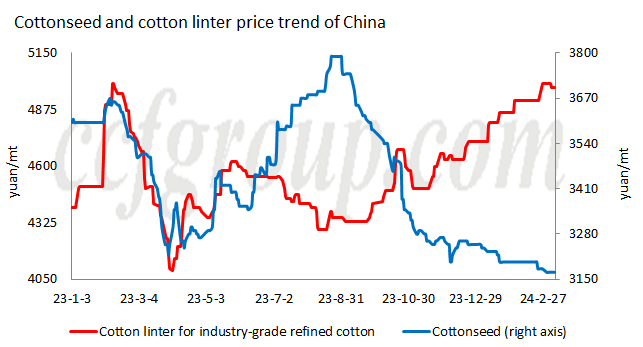Why cotton linter price keeps hiking?
Cotton linter market has extended the strong performance with prices rising further, which has been above 5,000yuan/mt outside Xinjiang after the Spring Festival. Is the current round of price increase due to strong downstream demand or some new changes in supply and demand relationships?

The current rise in cotton linter prices is neither pushed up by the cost resulting from higher cottonseed price nor by strong demand from cotton linter pulp and refined cotton mills. Instead, it is due to the reduced supply of cotton linter itself, leading to continuous price hikes. Since 2023/24 crop year started in Sep of last year, which was traditionally a season of substantial new cotton linters arriving at the market, prices have been lowered due to the increased concentration of arrivals. However, this round has seen a counter-trend rise in prices due to the difficulty in a concentrated arrival of new cotton linter.
Currently, Xinjiang-origin cottonseed prices have slightly rebounded to around 2,800yuan/mt, and those in inland are around 3,350yuan/mt, but high-quality cottonseed prices from Shandong, Hebei, and other regions are mostly at 3,150-3,200yuan/mt, with little fluctuation around the Spring Festival. Meanwhile, cotton linter prices have seen an increase of 200-300yuan/mt during the same period.
Since Q4 2023, the demand for cotton linter pulp and refined cotton has not been strong, but the increased restocking demand has contributed to the rise in cotton linter prices. Additionally, with limited operating rate and less supply of delinting plants recently, cotton linter price remains high amid less availability. Currently, Xinjiang cotton linter prices are around 4,600-4,700yuan/mt, and cotton linter for industry-grade refined cotton inland has risen to 5,100-5,200yuan/mt, with an increase of over 800yuan/mt since Sep last year.
In conclusion, there has not been new growth in cotton linter demand, but with the contraction in its supply, the additional output has decreased, providing favorable support from the supply side. Coupled with the recent essential replenishment demand around the Spring Festival, the cotton linter market sentiment is bullish, with producers becoming reluctant sellers, helping to drive prices higher. Before the deadlock in the cotton by-product market is broken and with relatively tight supply currently, cotton linter producers are expected to continue to quote firmly.
- Top keywords
- Cotton Price
- Cotton Futures Price
- Cotton Futures
- CZCE
- PTA Futures Price
- Chemical Fiber
- Polyester Prices
- Wool price
- PTA Futures
- Shengze Silk
- China
- Yarn Price
- price
- China Textile City
- Fibre Price
- Benzene Price
- Cotton
- Index
- Cotton Index
- PTA
- fabric price
- NYMEX
- Top 10
- textile industry
- Spot Cotton
- Cotton Yarn
- Polyester Price
- Futures
- PTA Price
- cotton yarn price

